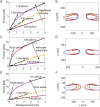Geometry of the nuclear envelope determines its flexural stiffness
- PMID: 32583742
- PMCID: PMC7521844
- DOI: 10.1091/mbc.E20-02-0163
Geometry of the nuclear envelope determines its flexural stiffness
Abstract
During closed mitosis in fission yeast, growing microtubules push onto the nuclear envelope to deform it, which results in fission into two daughter nuclei. The resistance of the envelope to bending, quantified by the flexural stiffness, helps determine the microtubule-dependent nuclear shape transformations. Computational models of envelope mechanics have assumed values of the flexural stiffness of the envelope based on simple scaling arguments. The validity of these estimates is in doubt, however, owing to the complex structure of the nuclear envelope. Here, we performed computational analysis of the bending of the nuclear envelope under applied force using a model that accounts for envelope geometry. Our calculations show that the effective bending modulus of the nuclear envelope is an order of magnitude larger than a single membrane and approximately five times greater than the nuclear lamina. This large bending modulus is in part due to the 45 nm separation between the two membranes, which supports larger bending moments in the structure. Further, the effective bending modulus is highly sensitive to the geometry of the nuclear envelope, ranging from twofold to an order magnitude larger than the corresponding single membrane. These results suggest that spatial variations in geometry and mechanical environment of the envelope may cause a spatial distribution of flexural stiffness in the same nucleus. Overall, our calculations support the possibility that the nuclear envelope may balance significant mechanical stresses in yeast and in cells from higher organisms.
Figures






Comment in
-
Editorial introduction.Mol Biol Cell. 2020 Jul 21;31(16):1651-1653. doi: 10.1091/mbc.E20-06-0414. Mol Biol Cell. 2020. PMID: 32692641 Free PMC article.
References
-
- Agrawal A. (2011). Mechanics of membrane– membrane adhesion. Math Mech Solids , 872–886.
-
- Agrawal A, Steigmann D. (2009a). Boundary-value problems in the theory of lipid membranes. Continuum Mech Thermodyn , 57–82.
-
- Agrawal A, Steigmann D. (2009b). Modeling protein-mediated morphology in biomembranes. Biomech Model Mechanobiol , 371–379. - PubMed
Publication types
MeSH terms
Substances
Grants and funding
LinkOut - more resources
Full Text Sources

